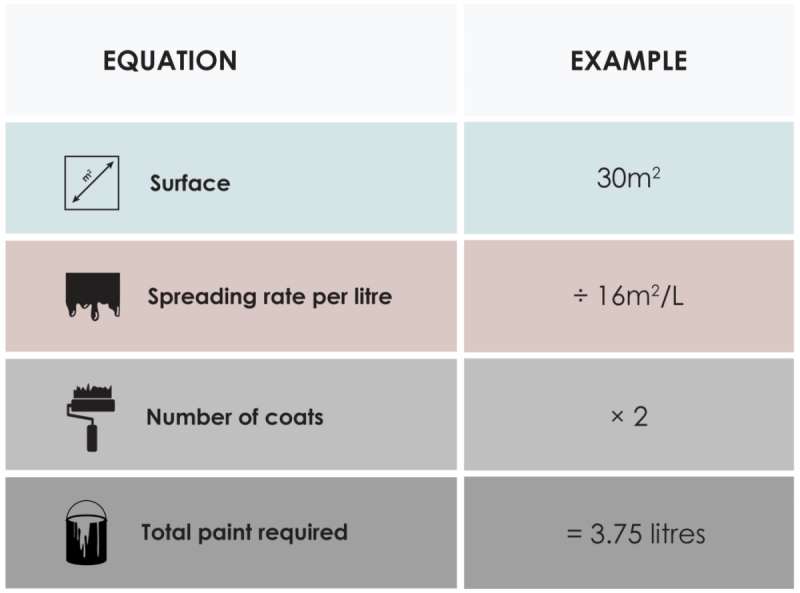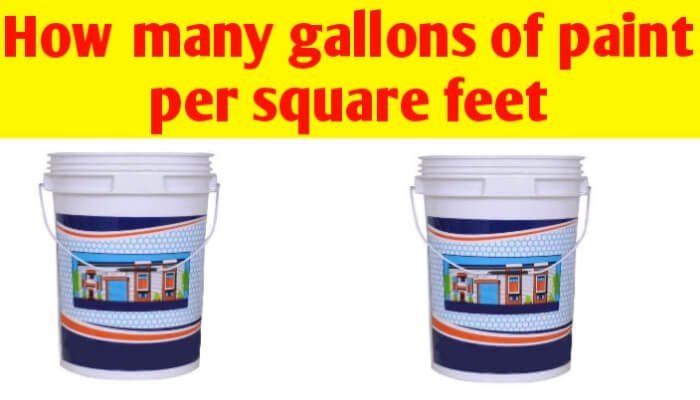Estimating Paint Needs for a Small Bedroom: How Many Gallons Of Paint For Small Bedroom

Painting a small bedroom can be a fun and rewarding DIY project. Before you start, it’s crucial to calculate the amount of paint you’ll need to ensure you have enough to complete the job without having to make a last-minute trip to the store. This will save you time and prevent any paint mismatches.
Calculating Total Square Footage
To determine the amount of paint you need, you’ll need to calculate the total square footage of the room. This involves measuring the walls and ceiling and adding the areas together. Here’s a step-by-step guide:
- Measure the length and width of each wall using a measuring tape. Record the measurements in feet.
- Multiply the length and width of each wall to find the area of each wall in square feet. For example, if a wall is 10 feet long and 8 feet wide, the area is 10 feet x 8 feet = 80 square feet.
- Add the areas of all four walls to find the total wall area.
- Measure the length and width of the ceiling. Multiply these measurements to find the ceiling area in square feet.
- Add the total wall area and the ceiling area to get the total square footage of the room.
Factors Affecting Paint Needs
Several factors can influence the amount of paint you need, including:
- Type of Paint: Different types of paint have varying coverage rates. Latex paint typically covers 350-400 square feet per gallon, while acrylic paint covers 300-350 square feet per gallon. Oil-based paint offers a higher coverage rate of 400-450 square feet per gallon.
- Condition of the Walls: If your walls are in good condition, you may only need one coat of paint. However, if the walls are damaged or have been previously painted with a dark color, you may need two or even three coats to achieve the desired coverage and color.
- Desired Number of Coats: The number of coats you apply will also affect the amount of paint you need. For a fresh, clean look, one coat may suffice. However, for a more durable and even finish, two coats are recommended.
Paint Coverage Rates
Here is a table illustrating the estimated coverage rates for different types of paint:
| Paint Type | Coverage Rate (square feet per gallon) |
|---|---|
| Latex | 350-400 |
| Acrylic | 300-350 |
| Oil-Based | 400-450 |
Factors Influencing Paint Quantity

The amount of paint needed for a small bedroom is not a one-size-fits-all calculation. Several factors come into play, influencing the total paint required and the number of coats needed for a professional-looking finish. Understanding these factors will help you estimate accurately and avoid running out of paint in the middle of your project.
Paint Type and Coverage
The type of paint you choose significantly impacts its coverage and the number of coats required. Different paint finishes have varying levels of opacity and sheen, affecting how much paint is needed to achieve a solid, even color.
- Flat Paint: Offers a matte finish, providing excellent coverage for hiding imperfections. However, it is less durable and more susceptible to staining than other finishes. Flat paint typically requires more coats than other finishes to achieve full coverage.
- Eggshell Paint: A slightly more durable option than flat paint, eggshell provides a soft, velvety finish with moderate sheen. It offers good coverage and hides minor imperfections, requiring fewer coats than flat paint.
- Satin Paint: This finish provides a smooth, low-luster sheen with increased durability and moisture resistance. Satin paint is a good choice for areas prone to spills or cleaning, such as trim and doors. It generally requires fewer coats than flat or eggshell paint.
- Semi-Gloss Paint: Offers a high-gloss sheen, making it ideal for areas requiring frequent cleaning, such as kitchens and bathrooms. Semi-gloss paint is highly durable and provides excellent coverage, typically requiring fewer coats than other finishes.
Wall Condition and Coverage
The condition of your walls also plays a significant role in determining paint coverage. New drywall requires more paint than previously painted walls, as the surface is more porous and absorbs more paint. Textured walls, such as those with orange peel or popcorn ceilings, may require more paint to achieve even coverage.
- New Drywall: Unpainted drywall is highly porous and absorbs more paint than previously painted walls. Expect to apply two coats of primer and two coats of paint for a smooth, even finish.
- Previously Painted Walls: Walls that have been previously painted generally require fewer coats of paint, especially if the existing paint is in good condition and the new color is similar to the old one. One or two coats of paint are usually sufficient.
- Textured Walls: Textured walls require more paint than smooth walls to achieve full coverage. The uneven surface requires additional paint to fill in the crevices and create a uniform color. Expect to apply two or three coats of paint to achieve a smooth, even finish.
Paint Brand and Coverage
Different paint brands and types offer varying levels of coverage and performance. Higher-quality paints often provide better coverage and durability, requiring fewer coats to achieve a professional finish.
- Premium Paint: Premium paint brands typically offer superior coverage, durability, and color retention. They are formulated with higher-quality pigments and resins, resulting in fewer coats needed for a smooth, even finish. However, premium paints can be more expensive than budget brands.
- Budget Paint: Budget paint brands may offer lower coverage and durability compared to premium brands. They may require more coats to achieve full coverage and may not be as resistant to fading, staining, or scratches. However, budget paints are generally more affordable than premium brands.
Additional Considerations for Paint Quantity

While calculating the square footage of your small bedroom provides a solid foundation for estimating paint needs, there are additional factors that can influence the final amount of paint you’ll require. These considerations ensure you have enough paint to complete the project without running out mid-way, leading to frustration and potentially inconsistent color results.
Preparing Your Small Bedroom for Painting
Proper preparation is crucial for a successful paint job. A well-prepared surface ensures that the paint adheres evenly and provides a smooth, lasting finish. This involves several steps, including:
- Cleaning: Start by removing dust, cobwebs, and any loose debris from the walls and ceiling. Use a damp cloth or sponge to wipe down surfaces, ensuring they are completely dry before proceeding.
- Patching: Inspect the walls for any holes, cracks, or imperfections. Use spackle or patching compound to fill these areas, allowing them to dry completely before sanding.
- Sanding: After patching, smooth out any rough edges or imperfections using fine-grit sandpaper. This creates a uniform surface for the paint to adhere to, resulting in a smooth, professional finish.
Paint Coverage Rates for Different Colors
Paint coverage varies depending on the color, with darker shades generally requiring more coats than lighter shades. Here’s a table outlining typical coverage rates for various paint colors:
| Color | Coverage per Gallon (Square Feet) |
|---|---|
| White | 350-400 |
| Light Colors (Beige, Cream) | 300-350 |
| Medium Colors (Green, Blue) | 250-300 |
| Dark Colors (Red, Brown) | 200-250 |
Essential Painting Supplies, How many gallons of paint for small bedroom
Having the right tools on hand can make your painting project smoother and more efficient. Here’s a list of essential painting supplies:
- Paintbrushes: Choose brushes with appropriate widths for corners, edges, and detailed areas.
- Paint Rollers: Select rollers with nap lengths suitable for the surface texture.
- Paint Trays: Use trays with liners to hold and distribute paint efficiently.
- Painter’s Tape: Mask off areas you don’t want to paint, ensuring clean lines.
- Drop Cloths: Protect floors and furniture from paint splatters.
Calculating Paint for Trim and Doors
Trim and doors often require a different type of paint than walls. Typically, semi-gloss or gloss paint is used for trim and doors, offering a durable and washable finish.
The coverage rate for trim and door paint is generally lower than wall paint, typically around 200-250 square feet per gallon.
To calculate the amount of paint needed for trim and doors, measure the total length of trim and the surface area of each door. Remember to factor in multiple coats for optimal coverage and a professional finish.
How many gallons of paint for small bedroom – A small bedroom usually requires just one gallon of paint, but you might need more depending on the size of the room and the number of coats you plan to apply. If you’re struggling with a small bedroom, consider maximizing your space with clever storage solutions and furniture choices, as explained in this helpful guide: how to save space in a small bedroom.
After you’ve optimized the space, you can confidently choose the right amount of paint for a fresh, inviting look.
The amount of paint needed for a small bedroom depends on the size of the room and the number of coats you plan to apply. A gallon of paint typically covers about 350 square feet, so you can calculate the necessary amount based on your room’s dimensions.
While you’re planning your bedroom refresh, consider adding a touch of convenience with a small mini fridge for bedroom. This can be a great way to keep snacks and drinks handy without having to leave your room. Once you’ve got your paint and your mini fridge, you’ll be well on your way to creating a cozy and comfortable bedroom space.
